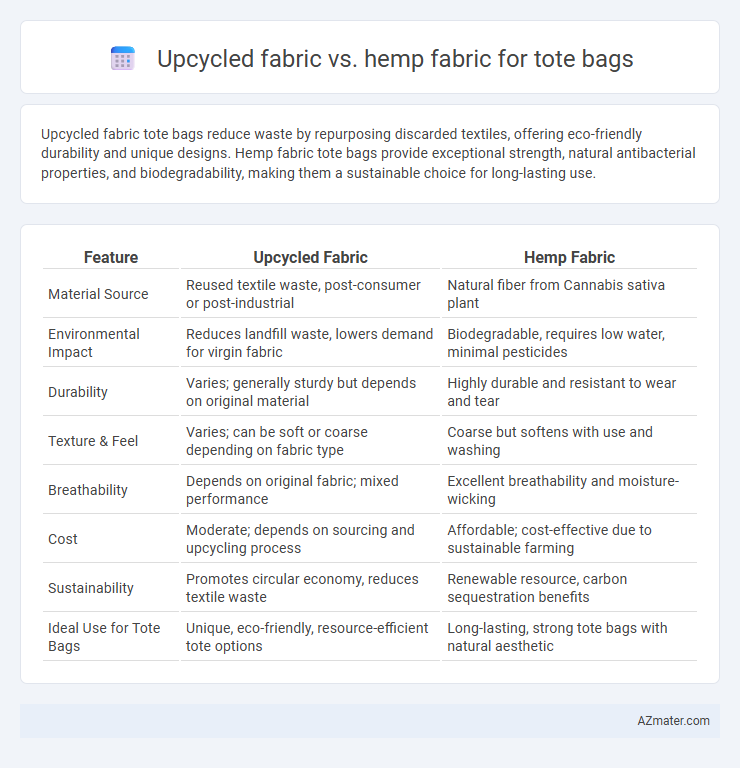Upcycled fabric tote bags reduce waste by repurposing discarded textiles, offering eco-friendly durability and unique designs. Hemp fabric tote bags provide exceptional strength, natural antibacterial properties, and biodegradability, making them a sustainable choice for long-lasting use.
Table of Comparison
| Feature | Upcycled Fabric | Hemp Fabric |
|---|---|---|
| Material Source | Reused textile waste, post-consumer or post-industrial | Natural fiber from Cannabis sativa plant |
| Environmental Impact | Reduces landfill waste, lowers demand for virgin fabric | Biodegradable, requires low water, minimal pesticides |
| Durability | Varies; generally sturdy but depends on original material | Highly durable and resistant to wear and tear |
| Texture & Feel | Varies; can be soft or coarse depending on fabric type | Coarse but softens with use and washing |
| Breathability | Depends on original fabric; mixed performance | Excellent breathability and moisture-wicking |
| Cost | Moderate; depends on sourcing and upcycling process | Affordable; cost-effective due to sustainable farming |
| Sustainability | Promotes circular economy, reduces textile waste | Renewable resource, carbon sequestration benefits |
| Ideal Use for Tote Bags | Unique, eco-friendly, resource-efficient tote options | Long-lasting, strong tote bags with natural aesthetic |
Introduction: Why Sustainable Fabrics Matter for Tote Bags
Sustainable fabrics like upcycled fabric and hemp fabric reduce environmental impact by minimizing waste and conserving resources. Upcycled fabric repurposes existing materials, preventing them from ending up in landfills, while hemp fabric offers biodegradability and requires minimal water and pesticides during cultivation. Choosing these eco-friendly materials for tote bags supports sustainable fashion and promotes a greener lifestyle.
What Is Upcycled Fabric?
Upcycled fabric is created by repurposing pre-existing textile materials, reducing waste and minimizing environmental impact. Unlike hemp fabric, which is made from the fibers of the hemp plant, upcycled fabric involves transforming discarded or excess textiles into new, durable materials ideal for tote bags. This sustainable approach conserves resources and adds unique character to each tote bag through varied textures and patterns.
What Is Hemp Fabric?
Hemp fabric is a natural textile made from the fibers of the hemp plant, known for its durability, breathability, and eco-friendly properties. Unlike upcycled fabric, which repurposes existing textiles, hemp fabric is sustainably grown with minimal water and pesticide use, making it a highly renewable resource. Its strength and resistance to wear make hemp fabric an ideal material for sturdy and long-lasting tote bags.
Environmental Impact: Upcycled Fabric vs Hemp
Upcycled fabric significantly reduces textile waste by repurposing existing materials, minimizing landfill contributions and lowering the demand for new resource extraction. Hemp fabric offers a sustainable alternative by requiring less water, pesticides, and land compared to conventional cotton, while being biodegradable and carbon-negative throughout its growth. Choosing between upcycled and hemp fabric for tote bags hinges on reducing environmental footprints through waste reduction and resource-efficient cultivation.
Durability and Longevity Comparison
Upcycled fabric made from reclaimed materials offers unique durability by combining the strength of original fibers with sustainable reuse, often resulting in increased resistance to wear and tear for tote bags. Hemp fabric is renowned for its exceptional longevity, characterized by high tensile strength, mildew resistance, and enhanced durability that improves with age, making it ideal for heavy-duty tote bags. Comparing both, hemp fabric generally provides superior long-term durability, while upcycled fabric emphasizes eco-friendly resilience through repurposed material strength.
Style and Aesthetics: Which Fabric Wins?
Upcycled fabric offers a unique, one-of-a-kind aesthetic with varied textures and patterns that appeal to eco-conscious fashion enthusiasts seeking individuality in tote bags. Hemp fabric provides a natural, earthy look with a smooth, durable finish that ages gracefully and complements minimalist, sustainable style trends. For those prioritizing distinctive, artistic design, upcycled fabric wins, while hemp excels for timeless, refined aesthetics.
Cost Analysis: Upcycled vs Hemp Tote Bags
Upcycled fabric tote bags typically cost less due to lower raw material expenses, as they reuse existing textiles, reducing production costs and waste. Hemp fabric tote bags, while more expensive upfront because of sustainable farming and processing, offer durability and biodegradability that extend product lifespan and value. The cost analysis reveals upcycled options as budget-friendly, whereas hemp bags provide long-term investment benefits through eco-conscious sourcing and quality.
Ease of Customization and Printability
Upcycled fabric offers high ease of customization due to its unique textures and patterns, making each tote bag distinctly individual, while hemp fabric provides a smooth, durable surface that enhances print clarity and color vibrancy. Hemp's natural fibers allow for sharp, long-lasting prints with eco-friendly inks, ideal for intricate designs and branding. Upcycled materials may require more detailed preparation for consistent print results, but they appeal to consumers seeking sustainable and one-of-a-kind aesthetics.
Consumer Perception and Market Trends
Consumers increasingly favor upcycled fabric tote bags for their eco-friendly appeal and unique, one-of-a-kind designs, aligning with sustainable fashion trends. Hemp fabric totes attract environmentally conscious buyers due to hemp's durability, biodegradability, and minimal water usage in cultivation, reinforcing its status as a green material. Market trends reveal a growing demand for both materials, driven by heightened awareness of textile waste and the shift toward sustainable consumer goods in the tote bag segment.
Choosing the Best Fabric for Your Eco-Friendly Tote Bag
Upcycled fabric offers a sustainable option by repurposing existing materials, reducing textile waste and environmental impact, while hemp fabric provides durability, natural antibacterial properties, and requires minimal water and pesticides during cultivation. Hemp's strength and biodegradability make it ideal for long-lasting tote bags, whereas upcycled fabrics contribute to circular fashion by giving new life to discarded textiles with unique patterns and textures. Choosing between upcycled and hemp fabric depends on prioritizing waste reduction versus raw material sustainability for your eco-friendly tote bag.

Infographic: Upcycled fabric vs Hemp fabric for Tote bag
 azmater.com
azmater.com